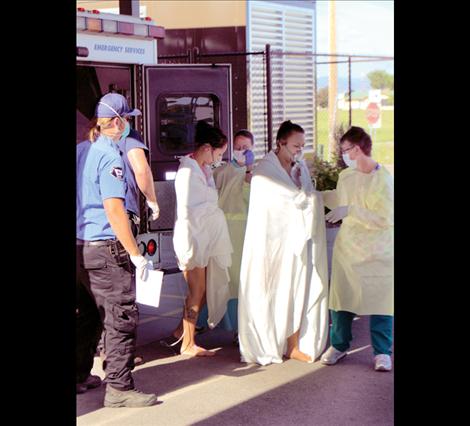Drill prepares responders, hospital for real life scenarios
Hey savvy news reader! Thanks for choosing local.
You are now reading
1 of 3 free articles.
RONAN — A joint training exercise encompassing Ronan Ambulance, Ronan Fire Department, Lake County Office of Emergency Management, Confederated Salish and Kootenai Tribes County Office of Emergency Management, Lake County Dispatch, Kicking Horse Job Corps, and St. Luke Community Healthcare took place on Wednesday, June 25.
Planned artificial events or drills that portray a real emergency situation are required twice a year for most health care organizations. The test was initiated by Steve Stanley, Lake County Emergency Manager. The purpose of this latest exercise was to test coordination and communication between different emergency agencies, as well to assess chemical decontamination procedures outside of and within the hospital.
The artificial scenario began at 9 a.m. as a crop duster plane was being loaded with Malathion at the Ronan Airport. A connecting hose burst, soaking two people with the potent insecticide. A call to 911 led to dispatch of the Ronan Fire Department. Throughout the United States, fire departments are trained to initiate cleaning of harmful substances known as decontamination or “decon” for victims who have been exposed to hazardous materials. Rapid decontamination is intended to remove or dilute the harmful substance, limiting further damage. As decontamination was completed by the local fire department, Ronan Ambulance responded to the scene to transport the two victims to the hospital.
Exposure to the harmful effects of Malathion can be experienced through inhalation, or breathing the product. Damage may also come through skin and eye contact, which may cause a systemic toxic reaction. Less likely as an exposure route is ingestion, or swallowing the poison. Exposure is important to consider, because emergency responders who arrive to give aid must guard against exposure in order to avoid becoming patients themselves. Since dispatch notified the fire and ambulance departments of the chemical involved in the emergency, both were able to research Malathion before reporting to the accident. As an extra precaution, the Ronan ambulance interior was swathed in thick plastic sheeting, and ambulance personnel were wearing masks and disposable protective clothing in order to safely receive and transport the victims.
Kicking Horse Job Corps medical students volunteered as victims and family members. The two “victims” reported symptoms from exposure to the hypothetical chemical spill, including headaches, trouble breathing, tremors, and anxiety. Two other “worried family members” drove to the hospital, anxious about the condition of their siblings.
At the hospital, Ronan Ambulance was met by St. Luke nurses, who quickly assessed the two “victims” and led them to the Decontamination Suite adjacent to the emergency entrance. Although decontamination may be done prior to transport, St. Luke Hospital routinely performs decon of contaminated victims upon arrival in order to assure safety for all patients, visitors, and staff.
Informed of the Malathion incident through dispatch messages, the St. Luke Community Healthcare HazMat Team was already dressed in personal protective equipment, including powered air purifying respirators and chemical resistant suits when victims arrived. Observers stood by to evaluate performance as the victims received treatment.
The HazMat drill ended with a “hot wash,” or evaluation of the event by all people involved. Lessons learned were shared and incorporated into future plans. Overall, the exercise was deemed a success, thanks to all parties involved.
“Full scale exercises are a great way to determine what works and what doesn’t,” said Linda Cox, SLCH Emergency Planner. “Wednesday’s drill went very well. We always learn something that will make our response better in the future, but I’m proud of everyone involved and what was accomplished. It may be challenging and expensive to practice together; but those who respond to emergencies know that practice makes a real difference. Thanks to everyone who participated in our Hazmat drill, our community is a safer place.”
















